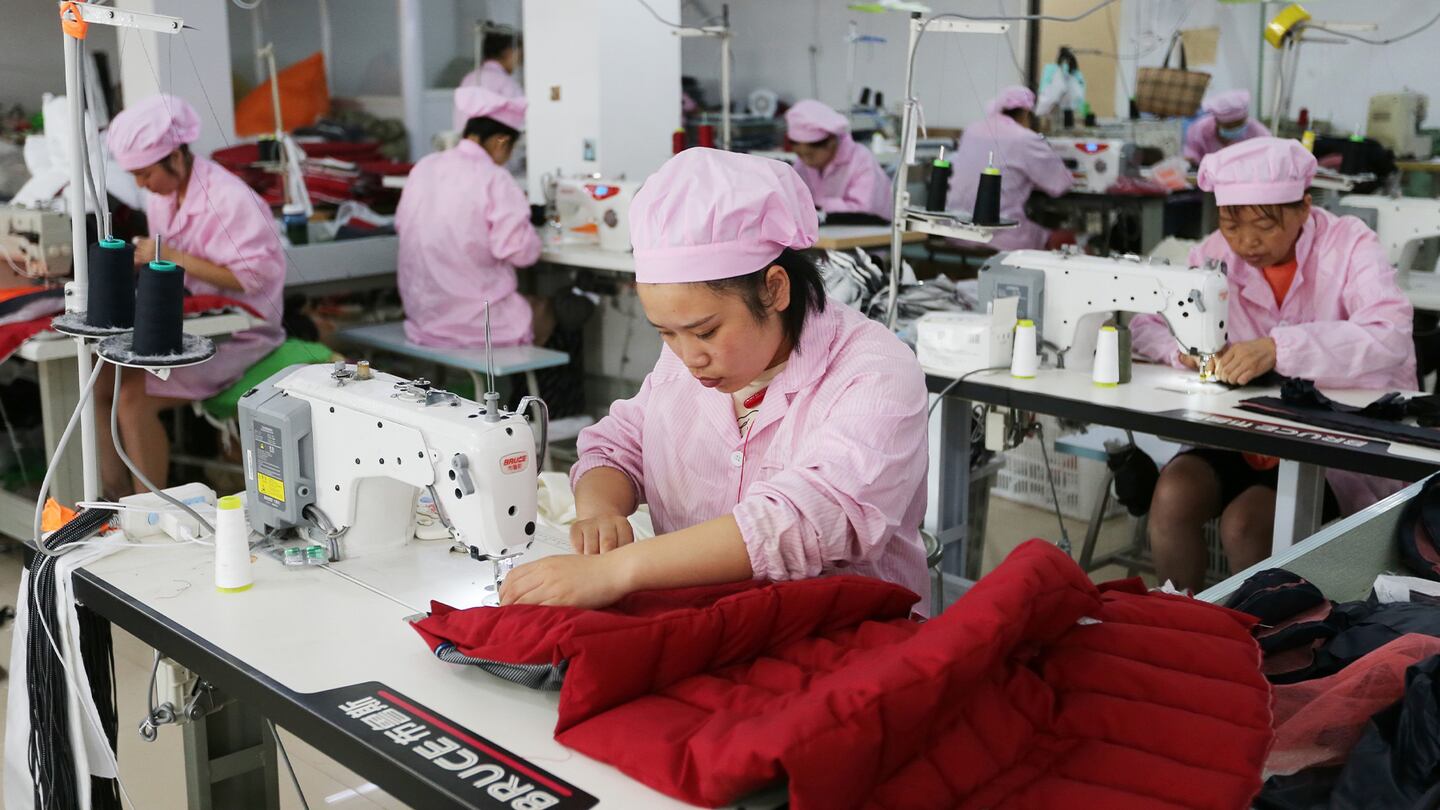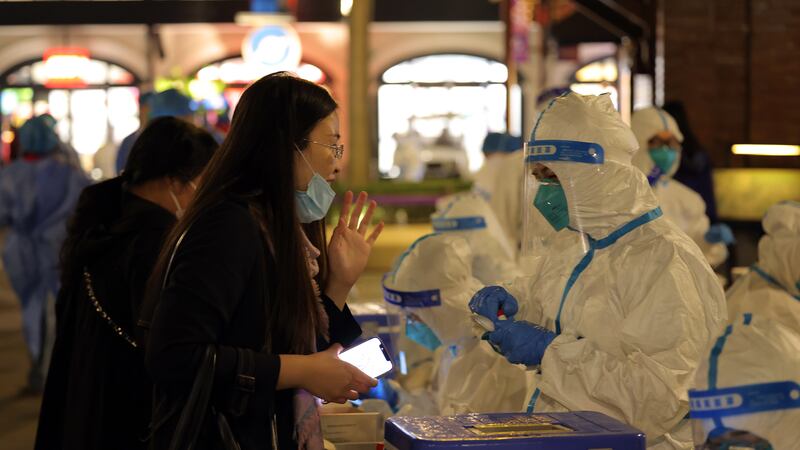
The Business of Fashion
Agenda-setting intelligence, analysis and advice for the global fashion community.

Agenda-setting intelligence, analysis and advice for the global fashion community.

With virtually no warning, factories around China have had their lights suddenly go out over the past month. “It has a massive impact. All of a sudden you get a notification that they are about to switch off the power,” said manufacturing veteran Gerhard Flatz.
Flatz is the managing director of KTC Group, a high-end activewear manufacturer based in Guangdong province that produces for European brands such as Mammut, Mountain Force and Helly Hansen. The company’s location in the Pearl River Delta has traditionally been a stronghold of fashion manufacturing, though some factory owners who made it their base have since offshored to other parts of Asia.
According to Flatz, his factory — which had back-up diesel generators on hand and was given some concessions from local authorities, who take into consideration “how big your tax bill is” in order to decide which factories “can get a bit of preferential treatment in the allocations” of power — was one of the lucky ones.
“Friends of mine [in the manufacturing sector] have had no electricity for weeks; they are so small they are not crucial [to the local government for revenue] and they get nothing,” he explained. “I believe overall, [power cuts] will have a massive impact on the textile supply chain of China.”
ADVERTISEMENT
Even as a series of supply chain shifts over the last decade has lessened the degree to which China is the “factory of the world,” it remains critical to countless fashion companies for sourcing and production.
According to the World Trade Organisation, 31.6 percent of the world’s apparel exports in 2020 came from China, along with 43.5 percent of global textile exports. When footwear, accessories, fibres and other raw materials and components such as trims, elastic, zippers and hang tags are taken into consideration, the proportion of the world’s fashion passing through the country is believed by supply chain experts in China to be as high as 60 percent.
Power shortages are now impacting more than half the country, adding to the list of headaches fashion players face locally. Not only have raw material prices (both in China and globally) soared since the onset of the pandemic while ports experience closures and disruptions, but sourcing materials such as cotton from China’s western Xinjiang region and products made with it have become increasingly fraught for global brands, as countries such as the US have banned them due to allegations of forced labour.
Globally, logistical logjams and a shipping container shortage have also contributed to longer wait times for products produced in China to make it to retailers and consumers in the West.
“Basically, every morning I wake up and think, ‘what new challenge will we face today?’ Then I just go and try to get some work done,” said Rebecca White, a Shanghai-based sourcing expert who works at HGR Consulting. She has spent years working with US-based wholesale and private label clients such as Amiee Lynn Inc and GMPC, supplying handbags, shoes, jewellery, hats, belts and scarves produced in China to retailers such as Macy’s, Walmart, Target and Lord and Taylor.
“I have a great picture [from a factory my client works with of a] guy with a battery powered light at his desk,” White said. The worker told White their electricity would be down from 4pm to 8pm every day — a schedule expected to continue until Chinese New Year, in the first week of February 2022. “The schedules are fixed and now it’s up to the factories to work around those times.”
What Triggered the Crisis?
Blackouts make life difficult for suppliers in China, but the country is stuck between a rock and a hard place when it comes to the shortage of fuel causing this crisis.
ADVERTISEMENT
It has been triggered partly by a nationwide push to diversify China’s economy away from coal, combined with flooding this year in major mining regions, and — to a lesser extent — a trade conflict with Australia that essentially eliminated the import of coal from the country.
As a result, China’s thermal coal prices have risen over 200 percent this year to record highs. A government mandate prevented power companies from passing that increased cost on to customers and led to the rolling blackouts.
It’s like war time. We’ll see who survives until next April, see if we can survive the winter.
If, as some anticipate, the blackouts last until Chinese New Year, when factories take around six weeks of holidays for their workers to return home to visit family, this means many orders won’t be complete until April, predicts Jane Goh, co-founder of PET (Plastic Ecological Transformation), a supply chain management company that collects recycled bottles to be made into polyester, then uses that material to make special-order corporate gifts and school and work uniforms.
Rather than placing orders for uniforms and gifts in small batches, as she normally would, to avoid excess inventory and waste, Goh’s current strategy is to place large orders that the factories can continually work on when they have “snippets of time” so that she has goods to sell leading up the all-important Chinese New Year holiday. She admits it’s a gamble.
“It’s like war time,” Goh said. “We’ll see who survives until next April, see if we can survive the winter.”
Impacts on Global Fashion Brands
Goh is unlikely to be the only one taking this approach, and many of the brands that found the agility, speed and flexibility of Chinese manufacturing to be a selling point in the past will have to adjust their thinking. Fashion players will increasingly need to plan ahead with larger orders to make up for the longer lead times created by the power crunch, in combination with on-going logistical disruptions.
As part of its recent fiscal first quarter earnings announcement, Nike executives said the company’s transit time to get goods from Asia to North America had doubled since the outbreak of the pandemic, to 80 days — even before power outages contribute to further delays.
ADVERTISEMENT
According to the American Apparel & Footwear Association’s senior vice president of policy, Nate Herman, “the shortages have mostly impacted material suppliers so far. We anticipate the shortages will exacerbate the record supply chain challenges we are currently faced with.”
Supply chain experts working in China hope this confluence of events might have a silver lining and lead to greater understanding and acceptance from brands and retailers of the challenges faced by their suppliers.
“I don’t think there’s a complete comprehension of the impact the power cuts truly have and when you are sitting thousands of miles away at your desk… you might not be thinking about these poor suppliers in China with no electricity every day,” White said.
“[But] there’s been a lot more acceptance of items that are late, [for example]… I do believe there is a lot more tolerance, for us and for everyone.”
I do believe there is a lot more tolerance, for us and for everyone [of disruptions and delayed deliveries].
In September, reports suggested that planned shutdowns in industrial hubs like Jiangsu, Zhejiang and Guangdong could send prices of textiles and garments up later in the year.
To date, the power outages have been focused on industrial centres, rather than residential or commercial centres in major cities, meaning global brands with a retail footprint in China have not yet been affected much at the store level. Though with many brands already facing the possibility of empty shelves in other international markets as a result of delayed orders, that might be of little comfort.
One likely outcome of supply chain snags due to China’s power cuts is the acceleration of manufacturing offshoring, which saw global brands leave China for lower-cost hubs prior to the pandemic, but later reshore to China from markets such as Vietnam, where factories had closed for extended periods in 2021 due to Covid-19 outbreaks.
But despite the economic case for preventing this loss of industrial output, there is another important factor making it less likely that China’s government will easily buckle to pressure from local businesses to dial up coal production: the pressure to lessen its reliance on coal because of the fuel’s harmful environment impact.
As Gerhard Flatz points out, the current power crisis is not just the result of a supply shortage, but the confluence of that shortage with an unforeseen spike in demand due to the recent reshoring from Southeast Asian countries.
It stands to reason that, if global Covid-19 disruptions decrease over the next year, that production won’t stay in China, but will return to lower cost countries.
“Why fire up coal plants to support business that is going to disappear anyway?” Flatz asked, rhetorically, adding that China’s government has worked to encourage the elimination of “cheap, dirty” production from the country and is unlikely to welcome its return.
“It’s not comfortable for [our business] but I support the mission of the government,” Flatz said. “They signed on to [climate targets] and now they have to execute on that. If it means some businesses are going down the drain, unfortunately, that’s necessary.”
The Bigger Picture
This is all happening as world leaders, with the notable exception of Chinese president Xi Jinping and others, meet in Glasgow for COP26, the UN Climate Change Conference.
The world’s second-largest economy is the world’s largest carbon emitter, largely due to the fact that almost 60 percent of the country’s economy is powered by coal.
In China’s non-binding Nationally Determined Commitments (NDC), previous pledges to reach peak emissions by 2030 and carbon neutrality by 2060 were reiterated, as was a promise to raise the share of non-fossil fuel energy consumption to 25 percent by 2030, but nothing new was brought to the table.
International disappointment in China’s NDC has not been assuaged by a recent pick up in coal production.
After Premier Li Keqiang said in early October that the government would support coal production to safeguard power supplies and “give priority to people’s livelihoods”, China’s daily coal output by mid-October hit 11.5 million tonnes, up more than 1.2 million tonnes from mid-September, the National Development of Reform Commission said.
Despite this recent uptick in production, Chinese suppliers, and those working closely with them, don’t expect the country to re-embrace its use of coal to an extent that will undermine its long-term climate goals.
Typically, business owners here figure out Plan Bs very quickly.
Though China’s government has maintained the support of its population in large part due to the country’s continued economic growth, the threat of catastrophic consequences of climate change happening on the watch of world governments — including China’s — is a potentially destabilising force that will compel Beijing to act in its own best interests, Goh suggests.
“I believe that [for the government] it’s a survival issue, not a PR issue,” she said.
White agrees, adding that however China’s apparel and textile manufacturing sector suffers due to the power shortages over the next few months, the disruption is likely to be smaller than that previous times of attrition — such as the period after tariffs introduced by the US government in 2018 pushed many small and medium-sized factories out of business, or when government-mandated environmental upgrades aimed at preventing water and ground pollution led to the closure of more factories that weren’t able to adapt to the new rules.
“With every round of challenges that are being faced by suppliers, you adapt, you become leaner and find better ways of working,” said White. “Typically, business owners here figure out Plan Bs very quickly.”
时尚与美容
FASHION & BEAUTY

Shenzhen Fashion Week Bets on Tech Prowess to Lure Brands
Shenzhen Fashion Week (SZFW) has upped its game this year, not only trialling a bi-annual format (previously it only held one edition per year) but also hosting 105 shows and presentations over its eight-day run, which wrapped up on Monday. According to Pan Ming, president of the Shenzhen Fashion Industry Association, this represents a record-high, and a 30 percent increase over its last edition. A total of 30,000 people attended fashion week events over the past week, with another million people watching shows broadcast online. SZFW is keen to play up Shenzhen’s strengths as an industrial hub for the fashion industry, as well as a centre of technology and innovation, and a key component of China’s grand plans for a Greater Bay Area economic zone (which also encompasses the Hong Kong and Macau). (BoF)
Li Ning’s $1.4 Billion Share Sale to Fund International Expansion
Chinese sportswear group Li Ning Co Ltd said on Thursday it planned to sell $10.5 billion Hong Kong dollars (US $1.35 billion) in new shares to raise capital for international expansion and for investment in newly launched product categories. The Beijing-based company plans to sell 120 million new shares, or 4.59 percent of the enlarged share capital, to its major shareholder Viva China Holdings Ltd, it said in a filing to the Hong Kong bourse. (Reuters)
科技与创新
TECH & INNOVATION

Alibaba’s Singles’ Day in the ‘Common Prosperity’ Era
Alibaba Group is setting a more sombre tone for its annual Singles’ Day shopping spree this year, as the retail giant foregoes hyping a sales boom in favour of focussing on sustainability amid calls by Beijing to promote “common prosperity.” In 2020, Alibaba expanded what it calls the world’s biggest online shopping festival from a one-day Nov. 11 event into a 11-day extravaganza, racking up $74 billion in orders, or “gross merchandise value” (GMV). This time around, the event comes at a time of much more stringent regulatory scrutiny for China’s biggest companies — including Alibaba — and the call to promote “common prosperity”. In 2021, Alibaba is formally promoting “sustainable development” and “inclusiveness.” (Reuters)
China’s Personal Data Protection Law Enacted Nov. 1
China’s Personal Information Protection Law (PIPL), first passed in August, is now in effect, dictating new parameters for the way data is collected, used and stored in the country. As well as applying to Chinese organisations, the PIPL also covers foreign firms that process the personal data of Chinese citizens overseas for the purpose of, for example, providing products and services to Chinese consumers as well as analysing the behaviours of those consumers. Under the law, international organisations will have to establish designated agencies or appoint representatives based in China to assume responsibility for matters related to the protection of personal data. (ZDNet)
消费与零售
CONSUMER & RETAIL

Vogue Café Opens at Galeries Lafayette Shanghai
The café, which opened on the second floor of Galeries Lafayette Shanghai, is the second Vogue Café in China, following the opening of a first branch in Beijing in November 2020. The social media-friendly 300-square-metre space serves Mediterranean food and afternoon tea, and on its walls are projections of exclusive video content, shot by Vogue China’s new editor-in-chief, Margaret Zhang.
政治,经济与社会
POLITICS, ECONOMY, SOCIETY

China’s Zero-Covid Policy Locks Down Shanghai Disneyland After One Case
Visitors to Shanghai Disneyland on Halloween were prevented from exiting the park in the evening as gates closed and metro lines shut, in response to a visitor to the park the day before later testing positive for Covid-19. Medical personnel in hazmat suits undertook tens of thousands of nucleic acid tests on site and the crowds were bussed home, where they were asked to self-isolate for two-days. Those caught up in the drama posting on social media poked fun at the surreal situation, with one visitor writing: “I never thought that the longest queue in Disneyland would be for a nucleic acid test.” Another 100,000 people who visited Shanghai Disneyland over the weekend will also be tested. The incident is emblematic of China’s zero tolerance to Covid-19 policy. (The Guardian)
China’s Manufacturing Activity Hits 20-Month Low in October
China’s official manufacturing purchasing managers index dropped to 49.2 in October (readings of 50 and above indicate expansion), according to data released by the country’s National Bureau of Statistics (NBS). This marks the second straight month of contraction and a more serious slowdown in October than in September when the index read 49.6. It’s the lowest reading since the outbreak of the pandemic in February 2020. The NBS blamed the slowdown on China’s ongoing power shortage and soaring raw material prices. (The Wall Street Journal)
 Opens in new window
Opens in new windowChina Decoded wants to hear from you. Send tips, suggestions, complaints and compliments to our Shanghai-based Asia Correspondent casey.hall@businessoffashion.com.
With consumers tightening their belts in China, the battle between global fast fashion brands and local high street giants has intensified.
Investors are bracing for a steep slowdown in luxury sales when luxury companies report their first quarter results, reflecting lacklustre Chinese demand.
The French beauty giant’s two latest deals are part of a wider M&A push by global players to capture a larger slice of the China market, targeting buzzy high-end brands that offer products with distinctive Chinese elements.
Post-Covid spend by US tourists in Europe has surged past 2019 levels. Chinese travellers, by contrast, have largely favoured domestic and regional destinations like Hong Kong, Singapore and Japan.